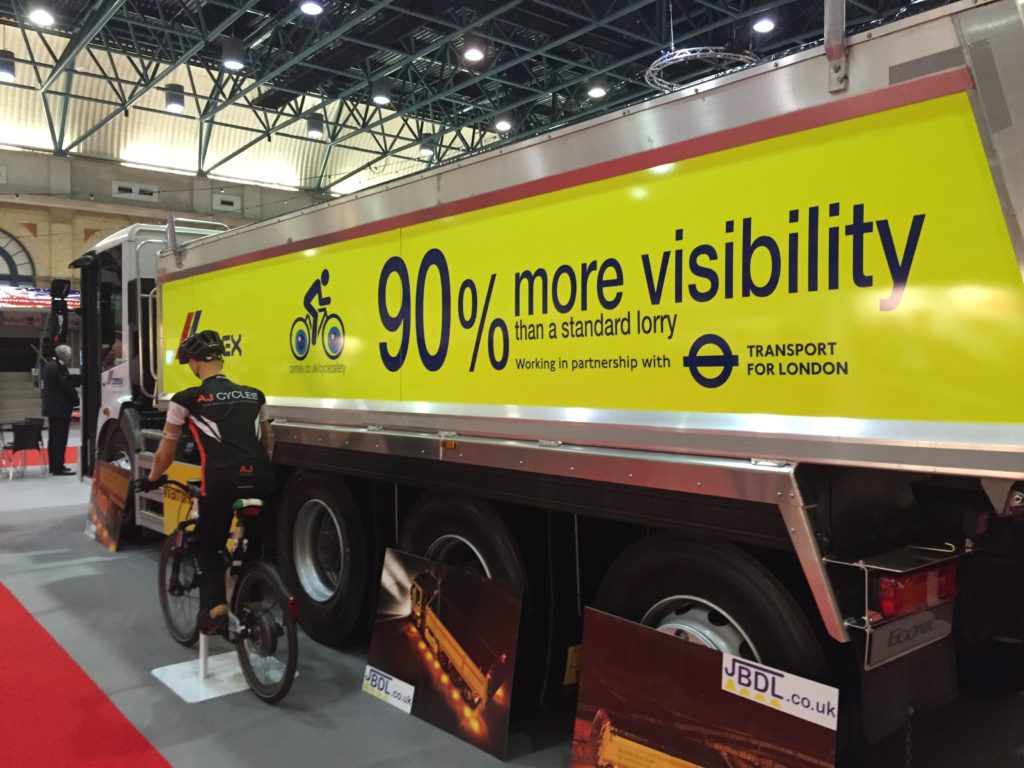The event at London’s Alexander Palace showcased the latest innovations in the logistics industry aimed at making deliveries to urban areas: quieter, cleaner and safer.
I recently attended the inaugural Freight in the City Expo on behalf of Plan to ensure that we remain informed of issues affecting our haulage insurance clients.
A number of seminars were held during the day with industry leading figures presenting their thoughts on these crucial subjects that will shape the future of freight transportation.
Safer
The safety seminar proved particularly insightful. A number of representatives from various cycle safety groups poised challenging questions to the panel of experts. However, it was clear that an enormous amount of sympathy existed in the room not only for the victims of road traffic accidents involving HGVs – but also for the drivers themselves.
A term used throughout the session was “cognitive fatigue.” It refers to the mental demands placed on drivers throughout the course of a long haul journey that takes them via a city’s centre.
Currently before initiating a manourvre a driver is required to check up to 6 mirrors. During the time it takes to complete these checks other fast moving road users could easily occupy the area covered by the mirrors at the start of the process. When combined with the other requirements of driving safely and following a correct route, the issue of potential overload and the huge draining affect become apparent.
The Freight in the City panelists highlighted how both vehicle design and vehicle selection are seen to be crucial to improving safety for vulnerable road users. There were a numbers of ways in which this could be tackled:
Reducing cab height
Currently 80% of freight deliveries into urban areas are completed by vehicles designed for use in quarries. As a result of being created for off-road use, the cabs of these vehicles are significantly higher than is necessary on a road.
This additional height dramatically increases the driver’s blind spot to the extent that 22 bikes could fit into the area that is obscured from view.
Improving vehicle selection
When surveyed, 50% of fleet managers couldn’t say why they had purchased a vehicle designed for use in quarries as opposed to the road specific version, even though their businesses were predominantly road based.
Therefore educating decision makers as to the importance of selecting journey appropriate vehicles will play a significant role in improving the safety performance of the road transport industry.
Motion sensors and cameras
These are seen by many informed observers as the most important innovation to aide HGV drivers. The cost of retro fitting the technology is perhaps prohibitive to most smaller operators.
However, with most new HGVs coming complete with censors and cameras as standard, we can expect to see a steady improvement in the industry’s safety performance in the coming years.
See-through doors
These are relatively simple to implement for manufacturers and will improve drivers’ awareness of other road uses passing on their side. The Mercedes Econic range already comes as standard with this feature.
Side bumpers
Instead of large gaps existing that potentially allow cyclists to fall under a HGVs substantial wheels, modern vehicles are being fitted with side bumpers that bounce the riders away from its under carriage – and hopefully to safety.

Safety is a core business value of Tarmac. Senior manager of national transport Steve McGrae demonstrated the numerous measures that his company implement to ensure this has real world outcomes. For example:
To improve concentration by reducing distractions they insist that their drivers adhere to a policy of “no hands free” at the wheel.
They also utilise breath detector technology that is linked to the vehicle’s ignition and prevents the vehicle’s engine starting unless zero alcohol is detected.
All new vehicles added to their fleet come complete with a full range of safety equipment and they have also retro fitted their entire fleet and vehicles of their contracted owner operators with motion detectors.
Extensive driving training is crucial to the success of their road safety efforts by helping drivers to understand the reasoning behind the measures, how to adhere to them and the potential implications of negating them.
These measures have seen a 10% reduction in insurance costs whilst helping to secure substantial contracts. Therefore, leaving aside thoughts of having a corporate conscience when viewed purely from a commercial perspective, these decisions make sense.
Civil Engineer and safety campaigner Kate Cairns gave a presentation that was heart breaking and thought provoking in equal measure.
Kate tragically lost her sister 5 years ago when a London lorry collided with her sister who was commuting on a bike at the time.
Kate revealed the flaws in the investigation and the lack of action taken by the authorities after the incident. She feels that it was only when the same lorry driver went on kill another pedestrian 18 months later that significant action was taken by the police and crown prosecution service.
Kate is founder of the See Me, Save Me campaign, that provides valuable insight into how road traffic incidents involving freight can be reduced.
Using her own professional background as an example, she believes dramatic improvements can be made if the construction industry were to give as much attention to health and safety procedures once a vehicle is in transport as they currently receive whilst present on construction sites.
It was eye opening to learn that twice as many pedestrians die in incidents involving HGVs as cyclists do.
As you can see a great deal of thought provoking information and debate came out of just one seminar. Further information on how CLOCS, FORS, the Noise Abatement Society and other freight related groups are working with the logistics and transportation industry to achieve safer, cleaner and quieter urban deliveries can be found at the at the Freight in the City website.

